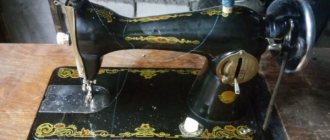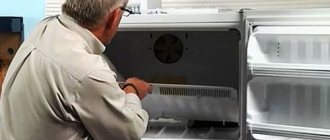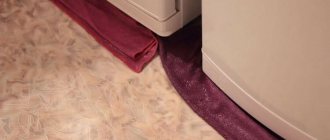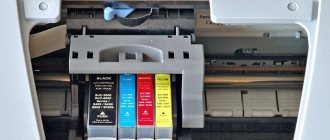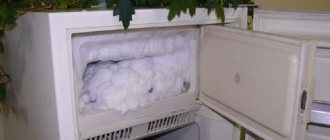Fault diagnosis
To understand the importance of the correct level of freon in the refrigerator, you need to understand the principle of operation of the mechanism. The refrigerant circulates through a sealed system of tubes. In the condenser, the gas is liquefied and releases heat to the environment, and in the evaporator it boils and takes heat from the refrigerator or freezer. Freon in a closed circuit does not deteriorate and effectively cools the refrigerator/freezer compartment for many years.
A freon leak can be suspected if the compressor is running, but the refrigerator/freezer compartment is not cooling.
Freon evaporates due to a leak in the circulation system.
A malfunction may occur due to:
- using sharp objects during defrosting;
- low-quality materials that have undergone corrosion;
- manufacturing defect;
- mechanical damage to the condenser or compressor.
Refilling with freon is performed if the gas has completely disappeared from the circuit or is gradually oozing from microcracks.
The importance of freon in the operation of a refrigerator
Freon is a gaseous substance that is odorless and colorless. During evaporation, the component absorbs heat, which is why refrigeration designers use it as a refrigerant. The substance is a safe component for human life and health, and also serves for a long time without losing its properties.
Situations where the cooling level in the chambers has sharply decreased or stopped completely indicate a lack of coolant. It is noteworthy that the compressor will continue to operate normally.
Refrigerant leaks can be detected by visual inspection or by using a “leak detector.” Freon loss areas are often located on the evaporator due to rust formation or manufacturing defects during soldering. Failure of a number of parts also causes loss. In view of this, the defective area should be eliminated and the mechanisms repaired.
Instructions on how to refill a refrigerator with freon at home allow you to carry out repair work yourself. However, security measures should be taken and technology should be studied to avoid aggravating the situation.
refrigerator operating principle
What malfunctions require freon replacement?
When replacing freon in the refrigerator, the technological process must be followed, since leakage of the substance is always associated with a violation of the seal. Common situations that professionals encounter are:
- Refrigerant leak. As a rule, the substance begins to seep in areas where soldering was carried out or in places of pitting corrosion. If such signs are present, the leak should be eliminated and then the system should be refilled.
- Clogged capillary line. A common cause is a decrease in oil level, constantly circulating in the system. The resulting dirt is caught by filters. If there are blockages, the coolant cannot move freely, causing the compressor to malfunction.
- Replacing the compressor motor, which involves filling the refrigeration equipment with coolant.
Please note: refrigerant leakage causes unit failure. Therefore, it is important to quickly identify the cause of the leak, eliminate it and fill the system with freon in the required quantity.
Equipment and materials
Replacing freon is a serious intervention in the design of the device, so special expensive devices will be required:
- Vacuum pumping station. Necessary for creating a vacuum in the system and then filling it with freon.
- Scales. It is necessary to very accurately weigh the amount of freon entering the system: a smaller or larger amount of gas will lead to another breakdown.
- Refrigerant. Brand and quantity are of fundamental importance. The necessary information can be easily found on the nameplate. You cannot change the brand recommended by the manufacturer. A small bottle of the most common refrigerant R600 costs about 500 rubles.
- Welding and soldering. The type of solder is selected depending on the type of tubes.
- Filter drier. It must be replaced whenever the system is depressurized.
- Schrader valve. Designed to create vacuum and high pressure.
- Leak detector. Required if the location of the damage is unknown. It is also used after work to check joints for leaks.
- Nitrogen cylinder. Needed to bleed the system.
REFERENCE! Equipment can be rented, since a one-time use will not cover its cost.
We pump freon
At this stage you will need a vacuum pumping station. It consists of two pressure gauges, red and blue, and three hoses. The connection and download procedure is as follows.
- Before connecting, the valves on the pressure gauges are tightly closed.
- The yellow hose located in the center is connected to the freon cylinder;
- The blue one is connected to the pipe through which the system is supplied. A special fitting is used.
- Red is connected to the other end of the system using a Schrader valve.
- Open the valves on the pressure gauges.
- The refrigerant supply opens. To make it easier to track the volume of pumped substance, it is recommended to install the cylinder on a scale.
- After reaching a pressure of 0.5 atmospheres, the valves close;
- The compressor turns on for 30 seconds.
- A vacuum pump is connected to the yellow hose and turned on for 10 minutes;
- The yellow hose is reconnected to the freon bottle.
- The valve on the blue pressure gauge opens and refueling continues.
- The compressor is turned on to ensure that the system is functioning properly and maintaining the recommended pressure.
- If no errors are made, the pipes are sealed after disconnecting the hoses.
The steps look quite simple, but require special knowledge and equipment. You shouldn’t get down to business if you don’t have at least one of the two listed above.
Note! Before carrying out work, it is worth checking the correct operation of the pressure gauges at the vacuum pumping station. Incorrect instrument readings will lead to excess or insufficient pressure in the system, which, in turn, leads to serious breakdowns.
Freon allows you to maintain a low temperature inside the refrigerator.
Preparation for repair
Before repairing the device, you need to perform several steps that will ensure safety and help avoid problems:
- Read the instructions for the refrigerator. Each model requires a special approach. This applies to the brand and amount of freon.
- Turn off the power supply to the refrigerator.
- Turn off electrical heating devices in the room. Freon is an explosive gas. For the same reason, during work you should not smoke or light a fire (for example, use a gas stove).
- Ensure the room is ventilated to avoid explosive gas concentrations in the air.
- Ensure that all equipment used is grounded.
When do you need to refill your refrigerator with freon?
Freon leakage cannot be tracked by any physical signs, since it has no color or odor. The surest way to determine whether freon refilling is currently needed is to check the temperature of the refrigerator. The greater the difference between the normal and actual temperature observed, the greater the freon leak that has occurred at the moment.
The cause of leaks may be mechanical damage to individual parts; before they are repaired, replacing the refrigerant will not make sense, as the likelihood of a repeated leak will be high. The main reasons for freon losses are:
- corrosion of tubes and metal elements of the condenser;
- breakage and mechanical damage of tubes;
- low quality tubes containing cracks of sizes invisible to the eye;
- incorrect pipe connection.
Only after correcting all the shortcomings of the refrigerator system can you begin refilling. Most of the parts require replacement; it makes no sense to repair different tubes separately.
See also -
Why does water accumulate under the drawers in the refrigerator?
Replacing freon in a refrigerator
Repair work is divided into several stages: complete removal of the refrigerant, purging the circuit, filling the system with new freon. For all manipulations, use a Schrader valve connected to the service pipe of the compressor.
Removing freon residues
The remaining freon (if any) is bled from the circuit. For safety, it is better to lead the hose out through the window to the street.
Then you should check the system for leaks: use a compressor pump to fill it with air. Bring the pressure to 15 atm if the coil tubes are made of aluminum, or to 25 atm if made of copper or steel.
Lubricate the tubes with a soapy solution where engine oil leaks are visible: these may be damaged areas. Air emerging from microcracks forms soap bubbles.
If the seal is broken, you must first solder the cracks. If there are no leaks, you can continue working.
Nitrogen purge
Nitrogen is needed to remove moisture from the system. If the nitrogen in the cylinder is under pressure above 6 atm, then it can only be filled into the system through a reducer.
Cut out the old filter drier and solder in a new one.
ATTENTION! The cooling circuit must not be left open for more than 15 minutes!
Pump out nitrogen using a vacuum pump station. In this case, the left pipe (blue) is connected to the compressor through the Schrader valve, the middle pipe (yellow) is connected to the refrigerant cartridge, and the right pipe (red) is connected to the pump that creates the vacuum.
Complete the process when the left pressure gauge needle shows minimum (-30). This will take 20-30 minutes.
IMPORTANT! You can’t rush at this stage: the remaining moisture can ruin the refrigerator.
Types of refrigerants
Refrigerants (English name), or freons (Russian name) are gaseous fluorinated hydrocarbons, colorless and odorless. Their common name is freons. They are designated by the letter R (from the English Refrigerant - cooler). Each specific type of refrigerant is designated by its own digital code.
Modern models of refrigeration equipment are filled with R134a and R600a refrigerants. These brands of freon do not damage the ozone.
R134a is a common refrigerant used in air conditioners and refrigerators. Safe.
Refrigerant R600a - isobutane - ensures the operation of many industrial refrigeration units, but is explosive when combined with air.
ATTENTION! The same manufacturer, for example Atlant, can use different types of refrigerant in different models of equipment. Accordingly, the brand of refrigerant, the amount of gas and the pressure in the system will be different.
The old equipment used R12 refrigerant, it was abandoned due to its destructive effect on the ozone layer.
In what cases is it necessary to charge a refrigerator with freon?
The leak cannot be seen by physical signs because it is colorless and odorless. It is important to know the most important method for diagnosing a leak. It is worth measuring the temperature inside the chamber. If it differs from the standard, this indicates a leak. Additional signs indicating a breakdown in the system:
- temperature readings exceed the norm;
- the compressor began to function without pauses;
- condensation began to form on the inside of the device;
- a foul smell appeared in the cell;
- the evaporator began to become overgrown with snow or ice.
When is it necessary to recharge the air conditioner?
Several signs indicate the need to refill/refill the air conditioner with freon.
What indicates a lack of refrigerant in the system:
- formation of frost and ice on fittings and pipe connections;
- frost appeared on the outdoor unit;
- The air conditioner began to cool the air poorly.
Refilling with freon is also necessary after dismantling and reinstalling equipment, as well as after repair work, which could result in a refrigerant leak.
Is a new air conditioner charged during installation?
Household air conditioners are sold already charged with refrigerant at the factory, so after installing new equipment there is no need for this. If the installation is carried out by technicians from a service center, they can check the pressure in the system using special equipment, which will also determine whether there is enough freon in the system for normal operation of the climate control equipment.
Air conditioning for a private house, cottage: types, selection, installation
Charging technology based on refrigerant weight
The essence of the method is to completely replace freon - the old gas must be released into the atmosphere, and fresh freon must be filled in instead. For beginners, this is the most acceptable option - only an experienced technician is able to determine the remaining refrigerant in the system and accurately refill the missing amount. We will describe other download methods below.
Connecting the manifold to the ports of the external module
Advice. Before refueling, correct the problem that caused the loss of old gas. Ideally, a split system should undergo a pressure test with nitrogen pumped under the maximum pressure specified in the product data sheet (usually 25-30 Bar).
We present instructions on how to charge an air conditioner with freon using a scale:
- Drain the old refrigerant into the atmosphere in any convenient way - through an unscrewed tube or spool of the service port. Release the gas slowly so as not to lose oil. While emptying, use the hexagon to open both taps hidden under the protective nuts.
- Close the taps and connect the left hose of the pressure gauge station (blue) to the spool. Make sure the manifold valves are also closed.
Connection diagram for vacuum - Connect the yellow middle hose to the vacuum pump fitting and start the unit. Open the left low pressure valve (on the left in the diagram) and watch the vacuum gauge - the arrow should fall below zero and show a value of minus 1 bar. Also open the service port valves.
- Evacuate the freon circuit for 20 minutes. After stopping the pump, wait half an hour while watching the pressure gauge. If the needle moves back to zero, look for a leak.
- Switch the hose from the pump to the cylinder, close the left valve of the manifold. Open the tank valve a few turns and purge the hose with freon. The operation is simple: open the right valve of the station (high pressure) for 1 second.
The filling vessel is connected with the same hose as the vacuum pump - Place the cylinder on the scale properly and reset the display to zero. Open the left manifold valve again and monitor the decrease in gas mass. When the display shows the required amount of refrigerant, close the tap.
- Close both valves on the service ports, disconnect the pipe from the spool and check the split system for operation.
Standard R410 refrigerant container must be inverted
Important point. Freon R410a is poured only in a liquid state, so the cylinder is placed on the scale upside down. During refueling, the flow of substance can be easily seen in the manifold inspection window. If the tank is equipped with a siphon or R22 refrigerant is pumped in, there is no need to turn the tank over.
During operation, it is important not to confuse the sequence of operations and not accidentally open the filled circuit. The minimum evacuation time is 20 minutes; during this period, the pump will remove not only air from the system, but also moisture that can harm the compressor. How to refill an air conditioner with R410a freon, watch the video:
Watch this video on YouTube
Preparing to refuel the system
First you need to decide whether your device needs refilling. There are several signs by which you can find out.
Refueling is definitely necessary if:
- During the installation of the equipment, defects were made that caused freon leakage, for example, a leak in the seal.
- The air conditioner was recently repaired.
- In case of a standard leak, the amount of refrigerant must be replenished.
It is very important to determine the type of freon that should be used to refill your device. This is important, because if you fill the air conditioner with freon of a different brand, you risk ruining the entire system.
Before you start refueling, use the remote control to set the temperature on the air conditioner to 18°C and select the cooling mode. To understand when to stop refueling, you need to look at the readings of a thermometer, which is brought to the place where air comes out of the indoor unit. Monitor the thermometer readings. A rise in temperature will indicate the end of refueling.
One of the most important stages of the charging process is the accurate calculation of the amount of refrigerant required. You need to calculate based on the power of the split system, the length of the pipeline through which the substance runs, and the type of mode in which the air conditioner operates.

